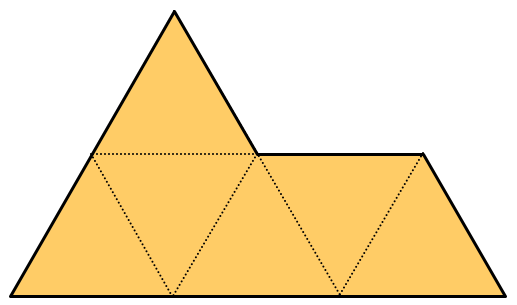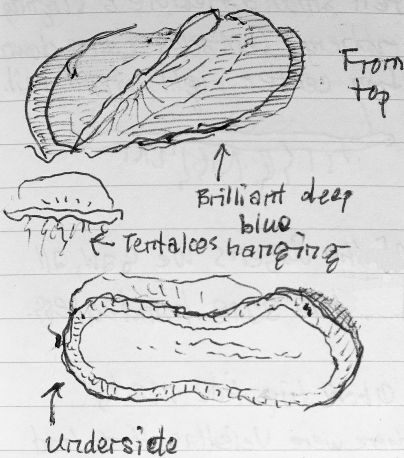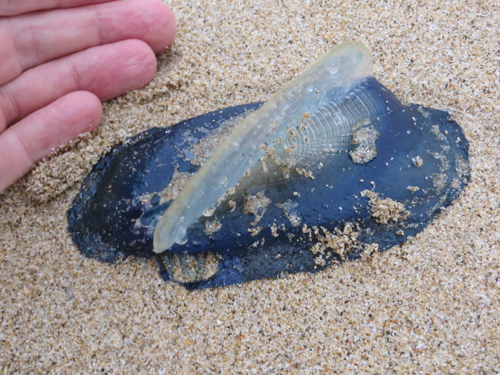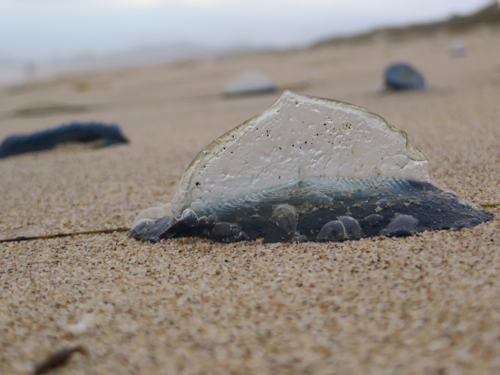
Standing in the creek bed of Purissima Creek, about two miles from Higgins Canyon Road.
Photo credit: Carol Steinfeld
Yet Another Unitarian Universalist
A postmodern heretic's spiritual journey.

Standing in the creek bed of Purissima Creek, about two miles from Higgins Canyon Road.
Photo credit: Carol Steinfeld
Twenty years ago this month, I began working as a Director of Religious Education (DRE) in a Unitarian Universalist congregation. During the recession of the early 1990s, I had been working for a carpenter/cabinet-maker, so I had been supplementing my income with part-time work as a security guard at a lumber yard. Carol, my partner, saw an advertisement for a Director of Religious Education at a nearby Unitarian Universalist church. “You could do that,” she said. So I applied for the job, and since I was the only applicant, I got it.

Above: Carol took this Polaroid photo of me sitting at my desk at my first DRE job. The computer in the left foreground is a Mac SE, and I have a lot more hair. It was a long time ago.
Over the past twenty years, I worked as a religious educator for sixteen years — full-time for six of those years, part-time for nine years — and as a full-time parish minister for four years. Since I was parish minister in a small congregation where I had often had to help out the very part-time DRE, I feel as though I’ve worked at least part-time in religious education for twenty continuous years.
Sometimes I wonder why I’ve stuck with it so long. Religious education is a low-status line of work. Educators who work with children are accorded lower status in our society, because working with children is “women’s work,” and ours is still a sexist society. And religious educators are sometimes looked down upon by schoolteachers and other educators, because we’re not “real” educators. In addition to being low-status work, religious educators get low pay, and the decline of organized religion means our pay is declining, too, mostly because our hours are being cut, or paid positions are being completely eliminated.
After a week of twelve hour days, getting everything set for the first day of Sunday school, I was ready for a break. When Carol suggested we go for a late-afternoon walk at Purisima Creek Redwoods Open Space Preserve, I was ready to go.
About an hour into our walk, Carol pointed down at the ground. “What’s that?” It was a small animal, dead. A mouse? No, a closer look revealed it was a mole. I turned it over carefully. There was a bit of a flat place where it had been lying; presumably decomposition was beginning. But you could still see the general shape of the animal. I admired it for a while then made a sketch, slightly smaller than the actual size of 110 mm total length, which I refined once we got home:
Of the two species of mole which inhabit our area, it was clearly a Shrew-mole (Neurotrichus gibbsii). According to Jameson and Peeters, in Mammals of California, we humans don’t really know what this species eats, or how it reproduces: “The Shrew-mole seems to feed indiscriminately on a board spectrum of soil-dwelling insects, pill-bugs, and centipedes”; it “appears to breed in late winter”; and “little is known of its reproductive habits” (my emphases). Another organism to which we humans live in close proximity, but about which we know little.
Usually, the myth of Persephone spending one third of the year in the underworld is supposed to explain why we have winter. But the climate in Greece is very like the climate in parts of California — winter is the rainy season, when the earth is green, and plants are growing. Martin Nilsson makes this point in his book Greek Popular Religion (New York: Columbia University Press, 1940), p. 51:
“For people who live in a northerly country, where the soil is frozen and covered by snow and ice during the winter and where the season during which everything sprouts and is green comprises about two thirds of the year, it is only natural to think that the Corn Maiden [Persephone] is absent during the four winter months and dwells in the upper world during the eight months of vegetation. And, in fact, this is what most people do think. But it is an ill-considered opinion, for it does not take into account the climatic conditions of Greece. In that country the corn [i.e., grain: barley or wheat] is sown in October. The crops sprout immediately, and they grow and thrive during our winter except for the two or three coldest weeks in January, when they come to a standstill for a short time. Snow is extremely rare and soon melts away. The crops ripen and are reaped in May and threshed in June. This description refers to Attica. The climate is of course different in the mountains, but Eleusis is situated in Attica. The cornfields are green and the crops grow and thrive during our winter, and yet we are asked to believe that the Corn Maiden is absent during this period. There is a period of about four months from the threshing in June to the autumn sowing in October during which the fields are barren and desolate; they are burned by the sun, and not a green stalk is seen on them. Yet we are asked to believe that during these four months the Corn Maiden is present. Obviously she is absent….”
And as I look out at the summer California landscape, where the hillsides are brown and dead-looking (especially this year, after three years of drought), I have to say it would make more sense that Persephone would be in the underworld right now, not in winter. In any case, although Nilsson’s book is a bit dated now, he reminds us that when the ancient Greeks thought of winter, they were not thinking of the stereotypical North American idea of winter, a time of snow and ice and cold.
But if this is not a myth about why it snows in winter, then what is it about?
Dr. Mara Lynn Keller, currently professor of women’s spirituality at the California Institute of Integral Studies, offers a feminist interpretation of the myth. Dr. Keller asserts that the myth of Demeter and Persephone focusses on “three interrelated dimensions of life: (1) fertility and birth; (2) sexuality and marriage; and (3) death and rebirth” (“The Eleusinian Mysteries of Demeter and Persephone: Fertility, Sexuality, and Rebirth,” Journal of Feminist Studies in Religion, spring, 1988, vol. 4, no. 1, p. 31). Keller states that there is evidence to show this myth is an allegory of the role of women in developing agriculture:
“Some archaeologists and anthropologists conclude that plant domestication and thus the gift of agriculture came through women. This theory is corroborated by the mythic core of the Eleusinian Mysteries, where Demeter is said to give the gift of grain to the people and instruct them in the rites to be continued in her name.” (ibid., p. 31)
Further, Keller identifies Hecate as a grandmother figure, so the myth also is about cross-generational bonds: “The story of Persephone, Demeter and Hecate lets us see the loving bonds of daughter, mother, and grandmother. During the epoch of the Goddess religions, women were honored at all stages of life.” (ibid., p. 39) It is a story that started out as an allegory of the cycle of life. Later on, as patriarchal cultures moved in and conquered the older Goddess-worshiping matriarchal cultures, women were relegated to a secondary role. That would imply that this myth comes from that later patriarchal era, when a male god can force a female goddess into marriage — violating in the process those cross-generational bonds — without her consent or even prior knowledge.
This feminist interpretation of the myth has been hotly debated, and some scholars argue that the archaeological evidence does not fully support such an interpretation. Whether or not that is the case, this myth offers plenty of fodder for examining gender roles and the ways women may be dominated by men.
There are, of course, plenty of other interpretations. Dr. Eric Huntsman, professor of ancient scripture, classics and Ancient Near Eastern Studies at Brigham Young University, summarizes some of the better-known interpretations of this myth in his lecture notes to Classical Civilization 241 (accessed 13 August 2014). Dr. Huntsman says this myth could be interpreted as:
— a myth related to the establishment of the Eleusinian Mysteries
— a nature myth about seed growth, and rebirth: Demeter allows no seeds to sprout on earth, when Persephone eats a seed she must return beneath the earth
— a myth about gender roles: females must struggle to define themselves in a world run by males
— a psychological myth about a young woman and her mother adjusting to the young woman’s marriage
— a psychological myth about a young woman growing up and figuring out her sexual identity
In short, this myth is not some pre-scientific attempt to explain why there are seasons!
I would like to suggest that there is at least some truth in several of these interpretations. Like a good poem, this myth contains multiple layers of truth and meaning, and these layers do not reveal themselves right away. Perhaps it is best that the layers of meaning reveal themselves slowly, over time. Emily Dickson could have been talking about the myth of Demeter and Persephone when she wrote:
Tell all the truth but tell it slant —
Success in Circuit lies
Too bright for our infirm Delight
The Truth’s superb surprise
As Lightning to the Children eased
With explanation kind
The Truth must dazzle gradually
Or every man be blind —
[poem #1263]
I’ve been researching a lesson plan for an upper elementary lesson on Oedipus and the Sphinx. This research led me to a mathematical game or puzzle involving sphinxes.
The “sphinx” of this puzzle is a five-sided figure, made up of six equilateral triangles:

This pentagon is called a sphinx because it looks a little like the giant Egyptian Sphinx at Giza — see below. In the image below, you can see that unlike the Greek Sphinx, the Egyptian Sphinx did not have wings. However, in spite of this difference, the Greeks traced the origins of their Sphinx back to Egyptian Sphinxes.
The interesting thing about the sphinx shape is that you can make larger sphinxes using smaller sphinxes (alternatively, you can dissect a larger sphinx into smaller copies of itself, though from a practical puzzle standpoint that’s difficult). Here’s how to try this out yourself. Below is a printable sheet of sphinx shapes that you can print onto heavy paper to be cut out:
Click here for a PDF of sphinx shapes for cutting out
OK, print out at least two sheets of the above PDF. Now here are several sphinx puzzles for you:
(1) Cut out 4 sphinx shapes to start, and make 1 larger sphinx shape from those 4. When you complete this puzzle, you have made a Size 2 Sphinx.
(2) Cut out a total of 16 sphinx shapes, and now make Size 4 Sphinx. (If you think about it for a moment, you should see an easy way to do this.)
(3) Making a Size 4 Sphinx was pretty easy, right? Now make a Size 3 Sphinx.
OK, those are the basic Sphinx puzzles. You’ve seen how smaller sphinxes can be made into larger sphinxes (or, conversely, how a larger sphinx may be dissected into smaller copies of itself). But this is just the beginning. If you want to keep going, here are some more challenges:
(4) We already said that making a Size 4 Sphinx is easy. But supposedly there are a total of 16 ways to make a Size 4 Sphinx. Can you find all 16 ways? (I have not yet done this.) Hmm, is there a proof to show that there are only 16 ways? (I have no idea!)
(5) Oh, and by the way, there are 4 different ways to make a Size 3 Sphinx. Can you find all 4? (I found this relatively easy.) Hmm, what about a proof showing there are only 4 ways? (Again, no idea!)
(6) It takes 4 sphinx shapes to make a Size 2 Sphinx; it takes 9 sphinx shapes to make a Size 3 Sphinx; it takes 16 sphinx shapes to make a Size 4 Sphinx. Do you care to predict how many sphinx shapes it takes to make a Size 5 Sphinx? (Easy.) Now try to make a Size 5 Sphinx. (Warning: not easy!)
(7) While you are at it, how about making a Size 6 Sphinx? And then can you make a Size 7 Sphinx?
(8) It’s easy to make a Size 8 Sphinx. That’s a lot of pieces to cut out, though — you can cheat by drawing 4 smaller sphinx shapes onto each sphinx shape. Will this technique help you make a Size 5 Sphinx? (Not really, but…) If not, what about making other shapes that can be subdivided into sphinx shapes — will that help? (For what it’s worth, one mathematician used this approach to try to prove how many different solutions there are to the Size 5 Sphinx.)
(9) There is 1 way of making a Size 2 Sphinx. There are 4 ways to make a Size 3 Sphinx; there are 16 ways of making a Size 4 Sphinx. Can you figure out how many ways there are to make a Size 5 Sphinx? (Warning: this is a problem that has challenged professional mathematicians, and to the best of my knowledge no one has proved how many solutions there are to a Size 5 Sphinx.)
There are still more puzzles and challenges to be found in the sphinx. You can find lots of them at the Mathematics Centre of Australia — click here.
The sphinx is one example of a rep-tile (self-replicating tiling), a polygon that can be dissected into smaller copies of itself. In shape, a sphinx is a pentagonal hexiamond (i.e., it has 5 sides, and it is made up by sticking 6 triangles together); further, it is an asymmetric rep-tile, since it comes in both left-handed and right-handed varieties and you need both varieties to dissect a sphinx. Note that a sphinx can be dissected into 4, or 9, or 25, or … copies of itself. According to the too-brief and not-entirely-accurate article at Wikipedia, the sphinx is the only (known?) pentagonal rep-tile.
Beyond this, I am getting in over my head. I think if the Sphinx had asked Oedipus to solve all 150+ Size 5 Sphinxes, he would have failed, she would have gobbled him up, and she would still be sitting outside Thebes terrorizing the city. Having said that, I would love to hear from you if you are a mathematician who can correct any errors I may made.
This afternoon, we went for a walk at Purissima Creek Redwoods Open Space Preserve in the Santa Cruz Mountains southwest of San Mateo. It was a stunning afternoon, warm but not too hot, with fog beginning to roll in up the canyons from the ocean.
As we hiked down into the preserve, we kept hearing a hawk screaming somewhere in the distance, but we never saw it. And then when we were hiking back up to the parking lot, there it was overhead: an accipter flying over the ridge we were on, then turning and riding the breeze coming up the canyon to our right. And what kind of accipter was it, a Cooper’s Hawk or a Sharp-shinned Hawk? I’d say it was perhaps a little larger, the neck a little longer, the tail a little more rounded, the wingbeats a little more deliberate: probably a Cooper’s Hawk, but I’m not good enough at field identification to be sure. It wheeled around, high above the canyon floor but at eye level for us; a couple of Band-tailed Pigeons came over the ridge, saw the accipter, and quickly ducked into the trees below us. Then the fog rolled up the canyon, and it was gone.
As we continued up the trail, Carol got about a hundred feet in front of me. Suddenly we both froze: walking the trail well up the hill in front of us was a dog-sized canid: a Gray Fox, its long tail behind it, its head turning from side to side, giving us a flash of the rufous fur up the side of the neck. It didn’t seem to notice us; it was busy watching the undergrowth on either side of the trail, and at least once it pounced at something.
We got back to the car a little after seven, and decided to go down to the beach to eat dinner. It was a beautiful foggy evening, and we walked along past Heerman’s and California Gulls, but the real attraction of the beach was the Velella velellas. When I was reading up on this species last night, I found a Web page by Dr. David Cowles that gave a possible reason why so many Velella velellas have washed up on northern California beaches:
“The angled sail makes it sail at 45 degrees from the prevailing wind. Some have a sail angled to the left, others to the right. Off California the right-angled form prevails, and these remain offshore in the prevailing northerly winds. Strong southerly or westerly winds, however, may bring huge aggregations ashore.”
We walked down the beach, making an unscientific survey: of the dozens of individuals we saw — ranging in size from less than two inches long to one that was as long as my notebook or approximately four inches (10 cm) long — all the sails had the same handedness (according to Dr. Cowles’ terminology, right-angled sails). Here’s a sketch from my notebook:

I picked one up by its sail to look at the tentacles hanging down underneath. The velellas, like the fox and accipter, are predators, feeding on smaller organisms with their dangling tentacles. The tentacles seemed to descend from the central oval, and were of varying lengths. The sail itself felt smooth, flexible, and slightly rubbery; I dropped it back into the waves after I had looked at it.
Three very different predators — but each one a fabulously beautiful organism.
My cousin and her husband were visiting from Seattle, and she wanted to go to the beach to see the sun set in the Pacific. So Carol and I and the two of them drove over the Coastal Range to Half Moon Bay.
“Maybe we’ll see the velellas,” said Carol. The velellas — scientific name Velella velella — are small bright blue creatures that are distant relations of the jellyfishes. They float on the surface of the ocean, feeding underneath the water with tiny tentacles, and being blown about by the wind on their small sail. Recently, hundreds of them have been blown up along the shore in San Francisco and Santa Cruz and Humboldt County. But I was skeptical that we’d see velellas, since I had seen nothing about them being blown onto beaches in San Mateo County.
When we got to the beach, the fog was so thick it was obvious that we weren’t going to see the sun set in the Pacific. But Carol said, with a big grin, “Look, the velellas!” Sure enough, all over the beach just above the line of waves, were these little blue things. The biggest one I saw would fit easily in my hand.

When you got down and looked at them closely, they were beautiful and amazing creatures. The San Francisco Chronicle interviewed Jim Watanabe, who works at the Hopkins Marine Station in Monterey County; the newspaper quotes him as saying, “They’re a nice reminder of the diversity of other life in the sea that we sometimes don’t think about.”

The velella turns out to be a highly interesting organism that is not particularly well understood, as this Web page from Walla Walla University points out.